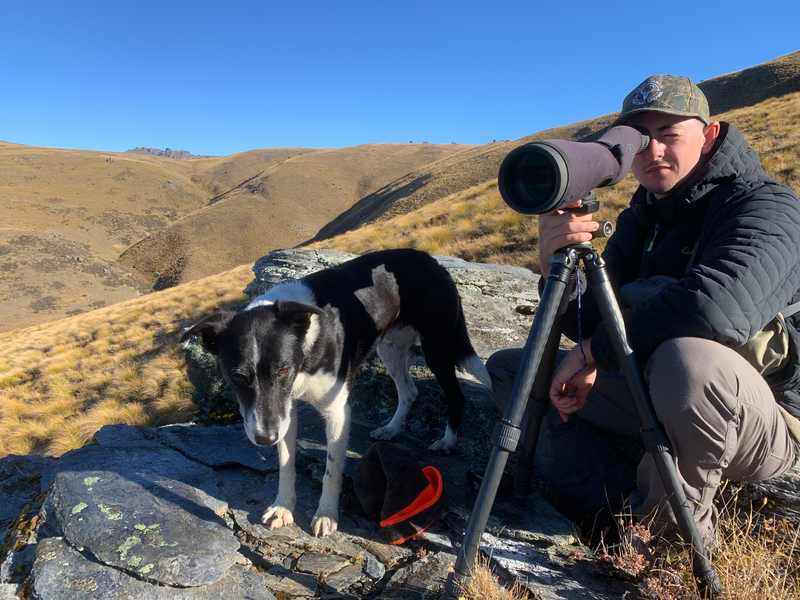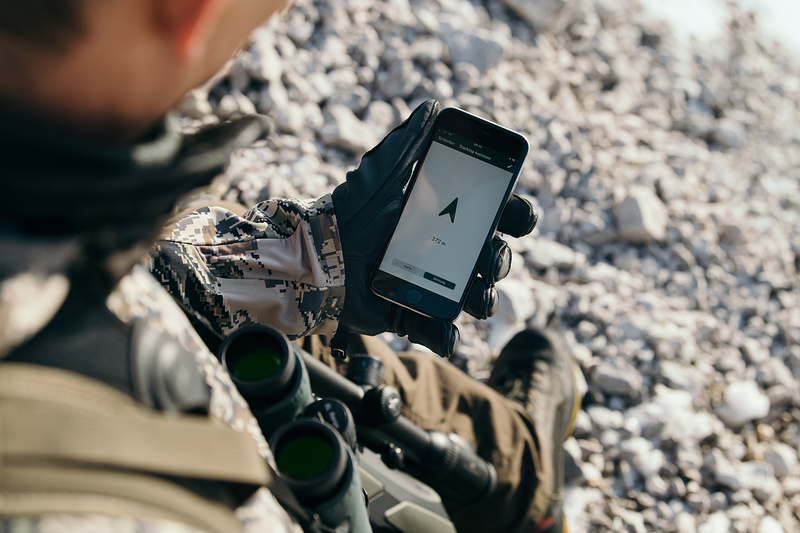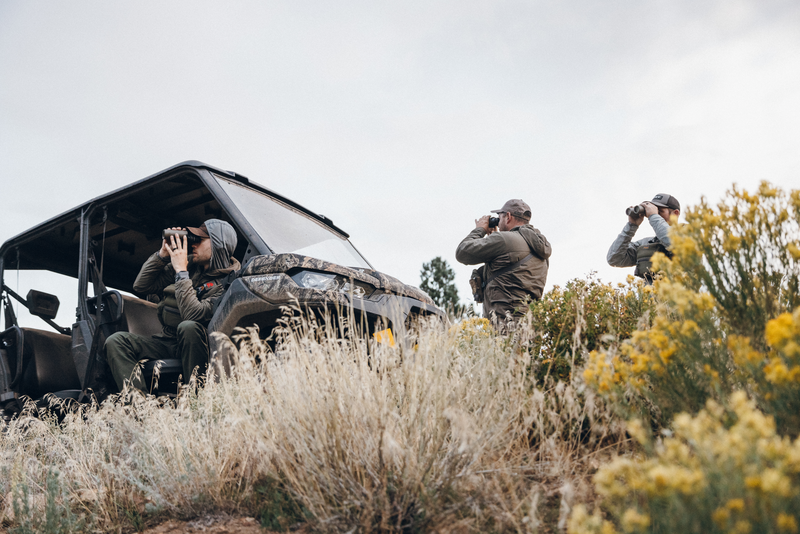Five Stars For Gunwerks’ Long Range University
By John Geiger, Managing Editor

Imagine it’s the last day of your hunt. You are on a mountain far from home. Your four-legged target is hundreds of yards away. The quality gun in your hands and the precision ammo in the chamber are up to the task. But are you?
There are so many advantages to getting good gear and learning how to use it correctly. You will be able to make a shot when you need to, and you’ll know how far is too far. Before, during and after the hunt, you will walk with more confidence. All these things are priceless.
Recently I leveled-up my long-range shooting ability by taking two shooting courses designed for hunters. Many training sites around the world offer similar courses. FTW Ranch in Texas, Gunsite Academy in Arizona, and Long Range Shooting in South Africa come to mind.
I spent four days with Long Range University near Cody, Wyoming. Experienced instructors combined PowerPoints, class discussion, and range time to demystify the act of precision shooting under pressure.
The courses — one called “Long Range Ballistics,” and the other “Advanced Ballistics and Wind” — were designed by Aaron Davidson, the founder and CEO of Gunwerks, a premium long-range factory-rifle-maker in Cody.

Our main tools were Gunwerks Magnus rifles in 6.5 Creedmoor, Hornady match ammo, Revic optics and a ballistic app on our phones.
A small group of students learned all aspects of long-range shooting for hunters, from the basics, like trigger-pull techniques, to the most advanced concepts, such as spindrift and the Coriolis effect.
First off, instructor Jeremy Winters went over each part of the rifle and explained its function. I thought this might be a good time for a nap, but he started with the scope and mentioned parallax.
I sat up straight in my chair when he explained how to adjust for parallax, how it’s related to focusing the diopter lens and what happens if it’s not set correctly.
That’s when I experienced my first of many “Wait. What?” moments. Over the next four days, there were many times when I realized I — for years — had been doing something wrong, setting a dial incorrectly or just not understanding a physics principle related to gear or shooting.
Long-range shooting is not intuitive, although many of us think we know it all. It was a blessing to have this time and hear it from experts, to take time to think about each concept, and to be able to follow up with questions. Even better, we’d walk out of the classroom and onto a 965-yard range we had to ourselves where we could test and prove these concepts with live firing.
I talked to several other students, and, like me, they knew a lot of what was presented. But they, too, were astounded about how little they knew about all the factors that go into accurate shooting at 100 yards or 1,000.
Let’s look at a few of these moments, and maybe they’ll help you shoot more accurately as well.
PARRALAX
Parallax is the difference in the apparent position of an object when it is viewed from two different lines of sight. As a demonstration of that, when you look at a needle on a car speedometer, you can move your head to one side and it shows you’re going 50 mph, and then move your head to the other side, and it reads 60 mph. But you might actually be going 55.

Parallax is this disparity of perception. Since it’s nearly impossible to put your cheek on the stock in exactly the same spot every time, you need to adjust the scope so the reticle prints exactly on the target. You can test this by adjusting the parallax knob usually found on the left-hand side of a long-range scope. If the parallax adjustment is set correctly, the reticle stays printed on the target no matter where you move your head. (Whenever you change your distance by about 50 yards or more, you’ll need to re-adjust for parallax.)
If you rest your thumb on the side of the grip, rather than wrapping it around the grip, you’ll avoid introducing resistance during the crucial nanoseconds when the bullet is still traveling down the barrel.
Anyone could see how this would be crucial for accurate long-distance precision. But it’s important even for sighting in at 100 yards. Without a properly set parallax (or the absence of a parallax adjustment option), you’ll never stack bullets consistently. Instead, your 1 minute-of-angle gun might shoot like a 1.5 MOA gun. It might not be the gun that is giving you loose groups, it’s the fact that your reticle and your point of aim are not matching up. Parallax is that important.
Hand-in-hand with the parallax adjustment is the diopter adjustment. This is the fine focus adjustment ring closest to your eye — not the power magnification, but the focus for your own eyesight.
Before you even touch the parallax knob, set the diopter so the reticle is in perfect focus. Dial the parallax so that the target is in clear focus. When you look through the scope with the gun secured, you will see no parallax.
Now you will have a crisp, obvious reticle, and you will stack your shots on the target even when your cheek is not in the exact same spot each time.
To me, this education about the diopter and parallax adjustments were worth the price of admission for the whole course.
MIRAGE
Mirage, the wavy distortion you sometimes see when you look far away, is caused by warm air rising from the ground. Before this course, I couldn’t see a good use for mirage when shooting. It made things hazy, and the target was harder to see. I never thought of it as an asset to reading the wind close to the target while hunting.

Instructor Ian Miner said two things that brought out another enlightening moment. The first is that the shape and direction of mirage closer to the target is an excellent way to judge the direction and speed of the wind near the target.
If you take your scope out of focus, and look closely, you can see wavelike characteristics of mirage. Wavy, lazy lines moving left to right indicate a slight left-to-right breeze and a modest wind hold, perhaps 2 MOA depending on the distance. Straighter lines at 45 degrees tell you the wind is stiffer, and you might need a 4 or 5 wind hold. Is the mirage moving straight up? Likely there is little wind, and a dead-on hold would be in order. Brilliant.
Second, Miner said that 70% of any bullet deflection by wind will happen within 200 yards of the shooter. This made no sense to me because I would have thought the wind would have its way with a bullet that was losing velocity and energy the farther out it goes. Nope. A bullet deflected near the shooter will be much farther from the point of aim than if the bullet is deflected closer to the faraway target.
So, I now read the wind near me, get a good feel for what it is doing, and then read mirage closer to the target, where it is much more difficult to judge. Combine the information, and you’ll make a much better overall wind call.

Calling the wind is, and likely always will be, an art not a science. It takes experience to read mirage and get a feel for how a breeze will affect your bullet’s flight. But there is a lot less voodoo than I thought when I first arrived in Cody.
I talked to several other students, and, like me, they knew a lot of what was presented. But they, too, were astounded about how little they knew about all the factors that go into accurate shooting, at 100 yards or 1,000.
RECOIL
Guns obey Newton’s third law — for every action there is an opposite and equal reaction. As the bullet flies forward, the gun flies backward and you get recoil. It’s important for the gun to move the same way every time it is fired — let the gun go where it wants to go after the trigger is pulled. Don’t restrict it, strap it down or touch the forend at the bench. But let it slide over the bags and into your shoulder.

That way, it will recoil without interference and your field shot point of impact will be a lot like your bench rest and prone point of impact.
Your trigger hand has a big role in this freedom-of-movement. Gunwerks’ Magnus rifle has a thumb shelf on the right side of the rifle where the stock meets the action. If you rest your thumb there rather than wrapping it around the grip, you’ll avoid introducing resistance during the crucial nanoseconds when the bullet is still traveling down the barrel.

Similarly, you’ll see a negative comb on all Magnus rifles, which means the stock’s comb will be lower in the front and higher in the back. It will fall away from your cheek weld at recoil not up against it, which could affect natural recoil movement.
Even the types of shooting bags you use contribute to accurate or inaccurate shots, said Winters. Plastic and some leather bags might stick to the stock or forend and disrupt the natural recoil movement. Then when you are shooting offhand, there is nothing to stick, so the POA will be different. Nylon or any materials that slide nicely with your stock is the way to go.
Along those same lines, the way you use your bipod or shooting sticks could mean the difference between driving tacks and loose groups.
When you are lining up a shot, “load” the bipod by pushing it slightly forward and down or driving it into the ground a bit. That will flex the legs slightly. The idea is, when the recoil starts, it will first take the flex out of the legs, and only then move the gun. That helps because user-introduced variations — your heartbeat, a flinch or a less-than-perfect trigger pull — will happen when the bullet is already in the air not still in your barrel. User error eliminated. Consistency achieved.
Speaking of recoil and accuracy, the instructors had a hot tip for keeping your gun on target after a shot. Some muzzle brakes can be positioned so that they direct the majority of the blast to the top left rather than straight up or to the side.
By sending those gases to the 10 o’clock position, it will negate the gun’s natural tendency to kick up and to the left. If you can set that break correctly, you’ll be able to fire your rifle and be much more likely to watch the effects of your bullet.
This is invaluable for many reasons, especially when you are hunting an animal in a herd. If you can watch what you hit, and follow your target, you will be ready right away to send another if necessary. If not, you’ll be waving your barrel around, turning down the magnification and desperately trying to re-acquire your trophy as the guide or PH is saying, “Shoot again! Shoot again!”
ETHICS
In any discussion of long-range shooting and hunting, invariably the question of ethics comes up. As it should.
“With great power comes great responsibility,” said instructor Winters. “We are not here to teach you how to shoot an elk at 1,000 yards. But we can teach you how to have full confidence with a 500-yard shot.”
Practice at extreme distances so you are confident at hunting distances. When you have quality gear and you know how to use it, you are a better hunter, and you’ll enjoy every aspect of the tradition.
Winters emphasized that long-range shooting while hunting should never be a competition. The distance is not as important a quick kill.
“If you’re not sure you can make a good, ethical shot, get closer,” he said.
Shooters should also be aware that there are usually many more variables when you’re hunting in field conditions — weather, uncomfortable positions, angles — as opposed to the bench or at a range.
“The shots you take while hunting, especially in mountains, likely reduce your maximum range by at least 1/3,” said Winters.

BEGINNINGS OF A BETTER SHOOTER
The instruction, gear and range at Gunwerks’ Long Range University were near perfect. I’ll bring much more confidence and skill along with me on my next hunt, whether for a mountain sheep or bean-field whitetail.
When I am looking through my scope, preparing to take the life of an animal at a distance, I will be a much better shooter. .
Inner Workings of Gunwerks

“Our customers are willing to pay more for a premium product that allows us to invest in new and innovative ways to help them find the best shooting solutions.”
Aaron Davidson, Gunwerks founder
Gunwerks was one of the original modern American gunmakers that focused on producing light, precision bolt-action rifles for Western mountain hunters. It was founded in 2006 by Aaron Davidson. The company creates every component of their rifles — except for the TriggerTech triggers — in their Cody, Wyoming, factory. The rifles with models such as the Magnus, Nexus and Werkman — range from $5,000 up to more than twice that. While they are factory rifles, they are about as close as they could be to custom builds because of the large number of variation customers can choose for each.
The company also owns Revic optics, which makes riflescopes, spotting scopes, laser rangefinders and an advanced ballistic app.
The company offers many different Long Range University courses that focus mostly on mountain hunting. They range from $500-$2,500.
A week with a Magnus and Revic optics proved that it was an excellent platform. The first five-shot group I shot piled up into one hole. The impact of long-distance shots to 965 yards were accurate, predictable and repeatable.
Gunwerks is one of those companies, if not the premier company, that others look to for innovations.
Whether it’s the negative comb, unique recoil-lug block in the forend, or double plunger ejectors, Gunwerks puts their money back into research and development to push forward precision shooting technology like few other companies can.
See more about the rifles and Long Range University courses and clinics at gunwerks.com.



